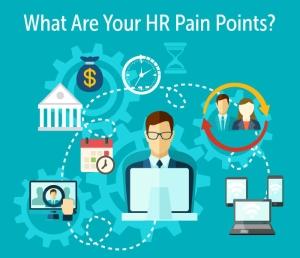An integrated talent management system (ITMS) may benefit your business by optimizing recruitment, onboarding, performance management, and other HR processes. An ITMS takes the manual effort out of managing a wide variety of talent-related tasks throughout an employee's career journey with your company — from initial job selection through developing skills and planning for promotions — which may result in financial savings and improved workplace efficiency. And with 48% of business leaders citing talent management as a top HR challenge this year, according to our 2025 Priorities for Business Leaders survey, the need for efficient solutions to retaining and growing your talent base is all the more pressing. If your business is preparing for growth, it's important to understand how an ITMS can be a crucial tool for organizational success and how it helps streamline essential HR processes.
What Is Integrated Talent Management?
Integrated talent management is an end-to-end process that combines all the pieces involved in identifying, attracting, developing, and retaining top-performing talent within an organization. In many companies, these tasks are handled as distinct work processes — often led by different HR team members. With an integrated talent management strategy, employers instead recognize the value of intertwining these tasks and consider how they affect an employee (and the organization) from beginning to end.
The integration of talent management can mitigate the risks of losing key personnel, reduce recruiting team costs, and increase overall productivity. It applies to business owners or HR professionals by providing robust data insights to help them make informed decisions on their employee's growth, training, and succession plans. They can leverage various tools and solutions to manage talent more effectively and align it with business strategies, resulting in a more talent-driven and agile organization. By investing in an integrated talent management system, businesses may be able to bolster their competitive advantage and scale their operations to new heights.
The Integrated Talent Management Model and Framework
The integrated talent management model is a comprehensive approach to managing talent-related processes, from acquisition to retention. This framework consists of several parts: workforce planning, talent acquisition, onboarding, performance management, learning and development, and succession planning. Each piece is crucial in ensuring the organization has the right people with the necessary skills and experience to achieve its goals. The model allows organizations to align their talent strategy with their business objectives, ensuring they have the right people in the right roles to drive success.
The backbone of a practical ITM framework is a holistic data management system that tracks all touchpoints for managing a single employee from beginning to end. With a comprehensive system, HR managers can analyze data and generate insights about any step in the talent management process, regardless of who owns or implements that step.
While there are several ways to approach an integrated talent management model, the most common example of this model in action is when organizations evaluate needs on a position-by-position basis. Key leadership will identify critical positions and develop an integrated plan to ensure the right employees are hired, trained, and developed to step into those roles when needed. Plans are also implemented to backfill less critical roles to minimize talent gaps and ensure the organization is always prepared for the future. In short, the integrated talent management model provides a structured approach to managing talent, often resulting in a more engaged and productive workforce.
Why Are Integrated Talent Management Strategies Important?
Integrated talent management strategies are crucial for business owners looking to maintain a thriving organization. Without an integrated approach, HR teams may develop disparate strategies for each task that often fail to consider the overall needs of the business. A siloed approach can often result in HR bottlenecks — either hiring too many people that eventually will result in layoffs, or not having enough talent at critical points in the business development lifecycle, ultimately leading to under-developed and overworked employees. In essence, an integrated talent management strategy is a tool for a business owner looking to build and maintain a strong and effective workforce.
Benefits of Integrated Management Systems
Implementing an integrated talent management model can bring numerous benefits to the business, including improved productivity, better retention of high-performing employees, more effective talent acquisition, and increased profitability. At the same time, employees stand to benefit from this model, as it can offer opportunities for career growth, skill development, and a more supportive and engaged work environment.
Here are some of the key benefits integrated talent management can provide:
- Improved productivity: An integrated talent management system can help improve workplace productivity by streamlining HR processes, providing valuable insights into employee performance, and enabling effective communication and collaboration among team members.
- Retaining key employees: Using an ITMS may provide opportunities for growth and development, recognize employee contributions, and create a more positive work environment, leading to longer retention of key employees.
- Improved staffing efficiencies and onboarding experiences: By automating administrative tasks and reducing time-to-hire, an ITMS can help get new hires integrated into your organization more seamlessly.
- Increased profitability: Business owners that use an ITMS may be able to leverage reductions in turnover and associated costs, optimized workforce performance, and improved business agility to recognize significant increases in overall profitability.
- Opportunities for career growth and skill development: A comprehensive talent management system can provide detailed insights into employee strengths and weaknesses, leading to more personalized development plans and identifying new roles and internal opportunities that match those skill sets.
- More effective communication and employee engagement: Leveraging an ITMS can help facilitate consistent feedback and coaching and encourage collaboration and recognition across the organization, leading to more open dialogue among team members at all levels.
- More apparent succession planning: With an ITMS, managers can identify high-potential employees and provide career development opportunities, creating a pipeline of skilled and capable leaders to fill key roles when needed.
How Does the Integrated Talent Management Process Work?
An integrated talent management process involves a systematic and strategic approach toward attracting, developing, and retaining top talent. It's a comprehensive system that supports optimal workforce performance and delivery of business objectives. The process includes the following steps:
- Talent acquisition: Identifying potential employees, screening resumes, and evaluating potential candidates.
- Performance management: Setting performance goals and standards, providing timely feedback and coaching, and conducting performance evaluations.
- Learning and development: Identifying skill gaps and offering training and development programs to fill those gaps.
- Succession planning: Identifying potential successors and preparing them for future roles.
- Compensation and benefits: Offering compensation and benefits packages that align with the organization's goals and industry standards.
By implementing an integrated talent management process, organizations can attract and retain top talent, boost productivity, and stay competitive.
Building an Integrated Talent Management Strategy
For business owners seeking to stay ahead of the competition, building an integrated talent strategy is crucial for long-term success. To begin the process of building a robust integrated talent management strategy, a business owner may consider exploring operational questions, including:
- Who are the top performers in my organization?
- What are the specific skills and experiences that make them stand out?
- What motivates them to perform at their best?
- What are my organization's key goals in the next 12 to 24 months?
- What knowledge or skill gaps within our team must be filled to achieve those goals?
Once a baseline understanding of the organization's current position is developed, the next steps include gathering data on employee performance, potential, and aspirations. Outside the organization, owners or managers involved in developing the ITM strategy should also develop a solid understanding of trends and industry benchmarks.
This information helps business owners and managers develop a comprehensive, integrated talent management plan aligned with the organization's goals, vision, and culture. By taking a thoughtful, data-driven approach, business owners can lay the foundation for a talent management strategy that drives business success and fuels growth well into the future.
Tips for Deploying Integrated Talent Management Systems
Building an effective integrated talent management strategy can be daunting in the competitive business world. However, it's essential to understand that this process can significantly benefit your organization. To help you get started, here are a few helpful tips.
- Take the time to define what your integrated talent strategy should look like. This means identifying your goals and objectives and outlining the processes and tools you'll need to achieve them.
- Invest in the right technology solutions that will help you streamline your talent management processes.
- Seek the expertise and guidance of experienced providers like Paychex, who can help you deploy and manage your integrated talent management system.
Following these tips can help you build a winning talent management strategy to support your organization’s long-term success.









